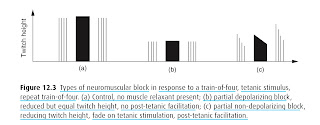Blood Gas Partition Coefficient
It is the ratio of the amount of anaesthetic agents present in the blood compared to gas when two phases are of equal volume and pressure and in equilibrium at 37 degrees Celsius.
⇒ Also called as Ostwald coefficient of blood gas.
⇒ It expresses the solubility of the agent in blood.
⇒ The higher the blood/gas partition coefficient, the more the agent is soluble. It will take longer to raise the agent's partial pressure in the blood.
Anaesthesia is related to the partial pressure of the anaesthetic agent at the effect site.
↑ B/G partition coefficient:
- ↑ Duration Onset time of anaesthesia
- ↑ Duration of Offset time of anaesthesia
↓ B/G partition coefficient:
- ↓ Duration of Onset time
- ↓ Duration of Offset time
The blood gas partition coefficient of the volatile agents:
- Halothane: 2.4
- Isoflurane: 1.4
- Sevoflurane: 0.6
- Desflurane: 0.4
Pharmacology for anaesthesia and intensive care, 4th edition
Smith and Aitkenhead's Textbook of Anaesthesia, 7th edition
Morgan and Mikhail's Clinical anesthesiology, 6th edition

Comments
Post a Comment
Please share your views and comments in the comment section. Give your opinion if there is anything to update.
Subscribe the channel to get updates regarding regular blog post.
Share the content if you think its appropriate.
Thank you.